J. Alyssa White1,2 & Rick J. Schulting1
1University of Oxford
2Museum of Anthropological Archaeology, University of Michigan
Individual No. 24 from the Tsukumo Shell-mound site in Okayama Prefecture, Japan was excavated in 1919 (Kiyono 1969). See Figure 43. Over the last century, numerous researchers have puzzled over his unusual burial position (Figure 44; Yamada 2001) and the degree of trauma present on his surviving skeleton. With the notable exceptions of the head and spine, the rest of his skeleton has extensive traumatic lesions consistent with being caused around the time of his death. As an international collaborative effort, my colleagues and I took on this cold case with the aim of better understanding the circumstances surrounding the death of individual Tsukumo No. 24, and in particular his brutal injuries. What we found was evidence for one of the oldest human shark attack victims (White el al. 2021).
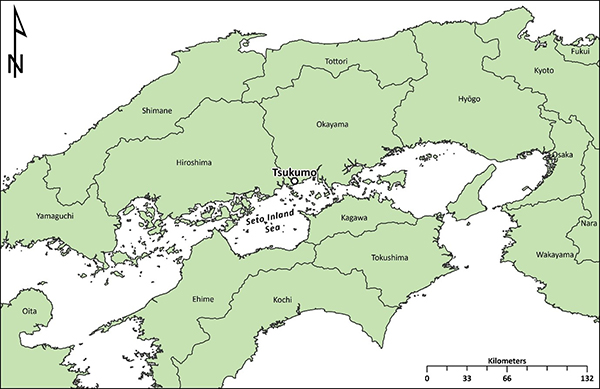
Figure 43. Map of the location of Tsukumo Shell-mound site in Okayama Prefecture, Japan.
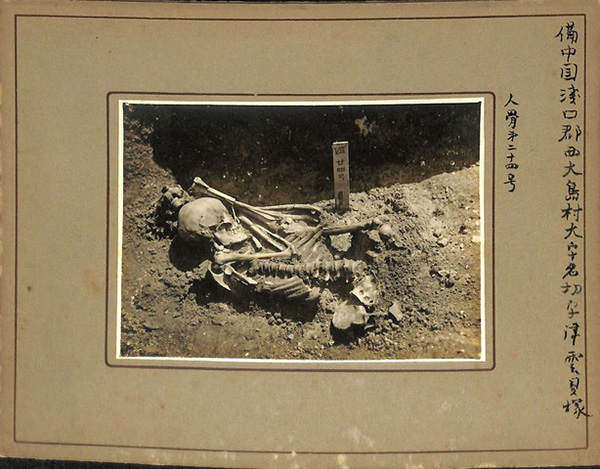
Figure 44. The original excavation photograph of Tsukumo Shell-mound site. You can see that No.24’s right leg was missing at the time of recovery and that his left leg was buried in an inverted position and atop his upper half. Photograph courtesy of the Laboratory of Physical Anthropology, Kyoto University.
Shark attack?
The first question that usually comes up when presenting this evidence is, how do you know it was a shark attack? The answer is that we determined this through a process of elimination.
What initially sparked our interest in the skeletal lesions on No. 24 was the possibility of warfare or violence, which we were in Japan to research at the time. The lesions on his skeleton are incredibly smooth and sharp, reminiscent of wounds caused by metal weaponry. Yet, during the hunter-gatherer period of the Japanese archipelago, there is no evidence for the use of metal weaponry (Hudson et al. 2021).
What differentiated the lesions on No. 24 from some kind of anomalous metal weapon use was the pattern of consistent, serrated wound profiles (Figure 45) and the distribution of gouges, punctures, fractures, and overlapping striations on his skeleton. If not the result of weaponry, then another common cause of trauma in the archaeological record is animal scavenging. Of the possible terrestrial scavengers present on the Japanese archipelago, none would cause the combination of lesions present (particularly the serrated lesions), even if some might cause punctures (such as dogs) or fractures (Fernández-Jalvo, Andrews 2016; Johnson 1985; Sorg 2019; Tsujino, Yumoto 2014; Ubelaker 1997).
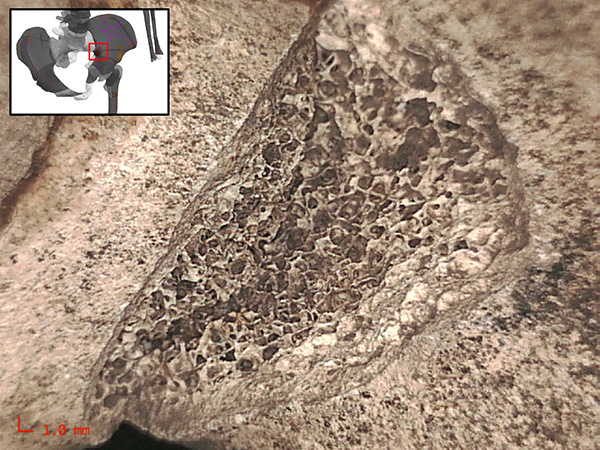
Figure 45. Close-up photograph of the largest gouge (33.2 × 20.2 mm, 21.3 mm deep) found on the skeleton, located on the left hip bone. On the right-most wall of the gouge, the scalloped edge is clearly visible. Photograph by JAW, courtesy of Kyoto University.
If we turn our focus to the sea, though, there are large predators with serrated teeth and a crushing bite that have been known to attack fishermen in the Seto Inland Sea, even in recent times: sharks. The vast majority of sharks do not preferentially or even occasionally attack humans, but of the attacks that do occur, three species in particular are implicated: tiger, (great) white, and bull sharks (Burgess 1991; Burgess, Callahan 1996; Caldicott et al. 2001; Clua et al. 2014; Coppleson 1962; Davies and Campbell 1962; Howard and Burgess 1993; İşcan, McCabe 1995; Nakaya 1993). Tiger sharks are even known to scavenge human remains in the sea (Ihama et al. 2009; İşcan, McCabe 1995; Rathburn, Rathburn 1984; Stock et al. 2017). Today, Japanese waters fall outside of the range of bull sharks, though white and tiger sharks are known to inhabit them. Within the Seto Inland Sea, white sharks were responsible for at least two attacks in the 1990s (Nakaya 1993; Schultz, Malin 1963). Based on estimates of sea surface temperatures (SST) in the prehistoric period, we can further conclude that conditions would have been most suitable for tiger (in the summer) and white sharks (in the winter) (Kawahata et al. 2017; Payne et al., 2018).
Yet, how likely would it have been for Tsukumo No. 24 to be, presumably, on a regular basis in shark-inhabited waters?
The archaeological context
Radiocarbon analysis of Tsukumo No. 24’s bone collagen (3090 ± 25 BP, 1370–1010 cal BC once adjusted for the marine reservoir effect) revealed that he lived during the Final Jōmon period of the prehistoric Japanese archipelago. As the name suggests, this period marked the twilight of a long (over 10k year) fisher-hunter-gatherer culture that spanned the archipelago. Stable isotopic analysis of individuals from the Tsukumo cemetery indicate that they regularly consumed marine foods, including predatory fish. Moreover, there is ample evidence of material culture relating to fishing practices from the site and more widely among the Jōmon (Kusaka et al. 2010; Tajima 2015).
Archaeological evidence of sharks dating to the Jōmon is not common, but they are present throughout the archipelago. Sharks are largely cartilaginous, meaning that their remains do not survive well in an archaeological context. Nevertheless, their vertebrae and teeth are exceptions (Steel 1985). Despite these limiting factors, we summarised evidence of prehistoric shark remains from the archipelago in an attempt to find what patterns were present.
We found reports of possible tiger and white shark teeth and vertebrae from 20+ Jōmon sites spanning from Okinawa to Hokkaido. Many reports do not specify the species of shark, unfortunately, so it was not possible to produce a detailed distribution map by species according to period. That being said, we know that shark teeth and vertebrae are present both as ornamental and/or ceremonial objects (Nakazawa et al. 2017; Watanabe 1990) and in contexts that indicate that they were likely a food item (Shimane Prefecture Board of Education 2019). Other evidence includes an engraving of a hammerhead shark on a potsherd (Takahashi, 1972) and, from the subsequent protohistorical Yayoi period, accounts of divers and fishermen tattooing their bodies to ward off large fish and fowl (Kidder 2007:14).
Importantly, during this period, it was common to construct cemeteries in shell middens. The calcium carbonate in the shells creates an excellent preservation environment for bone in conditions which, due to high precipitation and warm temperatures (Barnes 2022), tend to result in very poor to no skeletal preservation in Japan. At the Tsukumo Shell-mound site, the presence of a shark vertebra was reported (Tomioka 2020). After our paper was published in 2021, researchers at the Tsukumo site once more examined the animal remains from the site and found a shark tooth in the assemblage as well (M Nakatsukasa 2021, personal communication, 7 July).
Shark attacks
Examination of patterns found in modern shark attacks was invaluable in helping to determine what may have happened to Tsukumo No. 24. To our knowledge, previous detailed reports of archaeological shark attacks amounted to one case from Puerto Rico dating to ca. 1000 AD (c.f. Keegan, Carlson 2008). An even older case from the Americas has been suggested (Benfer 2008:373; Quilter, 1989:59), but needs to be more fully documented and presented. Therefore, it was imperative that we rely on the extensive forensic literature. Nevertheless, when we first came across images of the Puerto Rico case, we knew that we were onto something.
From modern cases, we know that unprovoked shark attacks largely fall into three categories – ‘hit-and-run’, ‘bump-and-bite’, and ‘sneak’ attacks. Of these, the latter are the most fatal and tend to result in more injuries, which would be most consistent with the Tsukumo No. 24 case. Sneak attacks are the result of a shark intentionally targeting a human as prey. These attacks usually occur in deeper water (Allaire et al. 2012; Auerbach and Burgess 2007; Burgess 1991; Caldicott et al. 2001; Howard, Burgess 1993; Lentz et al. 2010; Stock et al. 2017).
Forensic reports of injuries resulting from shark attacks categorise injuries into crushing, cutting, and tearing, which on the skeleton are best seen in blunt force fractures, (overlapping) striations from teeth dragging across bone, and incised bone gouges. The areas of the body most targeted are those more likely to be underwater (such as the extremities) and those that have more fat and muscle (such as the torso, including the buttocks) (Allaire et al. 2012; Auerbach, Burgess 2007; Coppleson 1963; Davies, Campbell 1962; Lentz et al. 2010).
Reconstructing the attack
The injuries to the victim’s remaining skeleton number over 790, ignoring severity of injury. His left hand (Figure 46), right leg, and most of his left foot all show evidence of traumatic removal. Based on the original excavation photo (Figure 44), his left leg was disarticulated by the time of burial and the right leg was missing. His hip bones and left leg show the largest and most numerous injuries. The front of his chest shows evidence of extensive fracturing and tooth marks. His arms and shoulders show evidence of bite marks as well, but these tend to be smaller than those seen on his lower body. The patterning of injuries in this case tells a gruesome story.
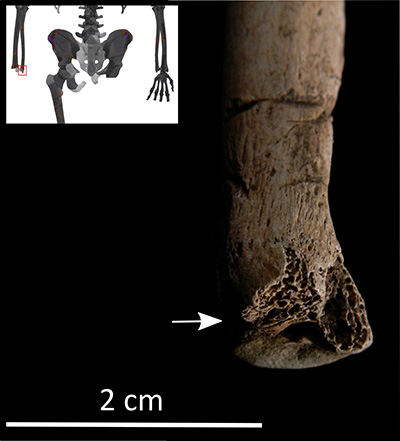
Figure 46. A photograph of the injuries to Tsukumo No. 24’s left ulna (at his wrist), where you can see that part of the bone has been sheared off and associated tooth marks. Photograph by JAW, courtesy of Kyoto University
According to George Burgess, former curator of the International Shark Attack File and a collaborator on this project, the first shark bite tends to be the largest and most traumatic. Therefore, we can surmise that the first bite was likely to the missing right leg. The loss of the individual’s left hand may have occurred at the same time while defending from these first bites. Injuries to the arms and hands often represent defensive wounds in the case of shark attacks (Ballas et al. 2017; Coppleson 1963). We know that the body was not in the water long enough for it to degrade significantly (due to how complete the skeleton is) (Haglund 1993). The simplest explanation is that the deceased’s left hand was sheared off when he was trying to defend himself from the shark, implying that he alive at the time of attack. His injuries are extensive and he would have bled out and gone into shock quickly. The number of injuries to the front of his body are best explained by a position in which the body floated face-down as the shark mauled him thereafter.
Companions must have been nearby or found him soon after, given the state of his body. He was buried in what was, presumably, the cemetery of his home village with respect and care.
Examine the evidence for yourself
As a part of our recording and examination of the injuries on Tsukumo No. 24, we mapped the preservation of the skeleton and the type and pattern of his injuries on a 3D model of the human skeleton using ArcGIS (see White et al. 2021 for more details). This model is freely available to interact with as a webapp, thanks to our collaborator John Pouncett (Figure 47), so that researchers and the public may interrogate the data for themselves.
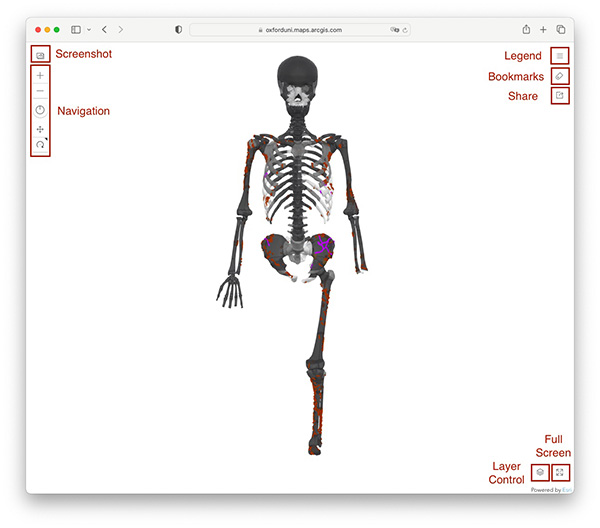
Figure 47. A screenshot of the Tsukumo No. 24 skeletal map webapp. The key features are labelled. Webapp by John Pouncett.
Shark species
We CT scanned the bones with the largest bite marks in the hopes of finding an embedded shark tooth fragment, but none were present. Both white and tiger sharks are capable of causing the serrated injuries found on Tsukumo No. 24. As mentioned previously, the prehistoric remains of both have been found on the archipelago and SST estimates indicate that the environment would have been ideal for either. Unfortunately, due to the severity and intensity of the attack, with numerous overlapping bites, we could not confidently isolate one to perform analyses, such as interdental measurements (cf. Lowry et al. 2009), to gain more precise details about the shark.
Take-away
It was our hope that by reporting on the Tsukumo No. 24 case in such detail that we could raise awareness of what kinds of injuries sharks can cause to the human body and their feeding behaviours. Humans and sharks have a long history of interaction with attacks on humans being just a small part of that relationship (Charpentier et al. 2020; Westbrook et al. 2018; Worm et al. 2013), yet one that is likely underreported in the current archaeological literature.
This case also demonstrates the value of re-examination of individuals housed in university and museum collections. When Tsukumo No. 24 was excavated, a majority of the research on human remains from the Jōmon period focused on questions of ancestry and descent – trying to determine how these individuals related to each other and the modern Japanese people. Research focus and questions shift over time and the ability to re-examine and cross-examine evidence is key to the scientific endeavour and to really knowing about how people lived in the past.
The oldest shark attack case known previously from the Japanese archipelago dates to the 19th century AD (https://www.sharkattackfile.net/index.htm). We now have evidence for a shark attack dating to approximately the 13th century BC, greatly recontextualising our understanding of human-shark relations in the (pre-)history of the Japanese archipelago. Nevertheless, some things remain the same. Today, fishermen are out in the Seto Inland Sea and so might be a passing shark, both going about their daily business (Figure 48).

Figure 48. A photograph of the Seto Inland Sea by JAW (2018).
Bibliography
- Allaire, M. T., Manhein, M. H. & Burgess, G. H. 2012. Shark-inflicted trauma: a case study of unidentified remains recovered from the Gulf of Mexico. Journal of Forensic Sciences, 57, 1675-8.
- Auerbach, P. S. & Burgess, G. H. 2007. Injuries from nonvenomous marine animals. In: Auerbach, P. S. (ed.) Wilderness Medicine. New York: Elsevier, Inc.
- Ballas, R., Saetta, G., Peuchot, C., Elkienbaum, P. & Poinsot, E. 2017. Clinical features of 27 shark attack cases on La Reunion Island. The Journal of Trauma and Acute Care Surgery, 82, 952–955.
- Barnes, G. L. 2022. Acid soils and acid rocks: misunderstood implications for bone preservation in Japan. In: Barnes, G. L. (ed.) Tectonic Archaeology: Subduction zone geology in Japan and its archaeological implications. Oxford: Archaeopress.
- Benfer, R. A. 2008. Early villages in South America. In: Pearsall, D. M. (ed.) Encyclopedia of archaeology. Academic Press.
- Burgess, G. H. & Callahan, M. 1996. Worldwide Patterns of White Shark Attacks on Humans. In: Klimley, A. P. & Ainley, D. G. (eds.) Great White Sharks: The Biology of Carcharodon Carcharias. Academic Press.
- Burgess, G. H. 1991. Shark attack and the International Shark Attack File. In: Gruber, S. H. (ed.) Discovering Sharks. Highlands, New Jersey: American Littoral Society.
- Caldicott, D. G. E., Mahajani, R. & Kuhn, M. 2001. The anatomy of a shark attack: a case report and review of the literature. Injury, 32, 445-453.
- Charpentier, V., Adnet, S. & Cappetta, H. 2020. The tooth of a giant sea creature Otodus (Megaselachus) in the material culture of Neolithic maritime hunter‐gatherers at Sharbithat (Sultanate of Oman). International Journal of Osteoarchaeology, 30, 835–842.
- Clua, E., Bescond, P. M. & Reid, D. 2014. Fatal attack by a juvenile tiger shark, Galeocerdo cuvier, on a kitesurfer in New Caledonia (South Pacific). Journal of Forensic and Legal Medicine, 25, 67-70.
- Coppleson, V. M. 1962. Shark Attack, Sydney, Australia, Angus and Robertson Ltd.
- Davies, D. H. & Campbell, G. D. 1962. The aetiology, clinical pathology and treatment of shark attack (Based on observations in Natal, South Africa). Journal of the Royal Naval Medical Service, 48, 110–136.
- Fernández-Jalvo, Y. & Andrews, P. 2016. Atlas of Taphonomic Identifications: 1001+ Images of Fossil and Recent Mammal Bone Modification, Dordrecht, Springer Netherlands.
- Haglund, W. D. 1993. Disappearance of soft tissue and the disarticulation of human remains from aqueous environments. Journal of Forensic Sciences, 38, 806–815.
- Howard, R. J. & Burgess, G. H. 1993. Surgical Hazards Posed by Marine and Freshwater Animals in Florida. The American Journal of Surgery, 166, 563–567.
- Hudson, M. J., Bausch, I. R., Robbeets, M., Li, T., White, J. A. & Gilaizeau, L. 2021. Bronze Age globalisation and Eurasian impacts on later Jōmon social change. Journal of World Prehistory, 34, 121–158.
- Ihama, Y., Ninomiya, K., Noguchi, M., Fuke, C. & Miyazaki, T. 2009. Characteristic features of injuries due to shark attacks: a review of 12 cases. Legal Medicine (Tokyo), 11, 219-25
- İşcan, M. Y. & McCabe, B. Q. 1995. Analysis of human remains recovered from a shark. Forensic Science International, 72, 15-23.
- Johnson, E. 1985. Current developments in bone technology. Advances in Archaeological Method and Theory, 8.
- Kawahata, H., Matsuoka, M., Togami, A., Harada, N., Murayama, M., Yokoyama, Y., Miyairi, Y., Matsuzaki, H. & Tanaka, Y. 2017. Climatic change and its influence on human society in western Japan during the Holocene. Quaternary International, 440, 102–117.
- Keegan, W. F. & Carlson, L. A. 2008. First Documented Shark Attack in the Americas circa AD 1000 (2003). In: Keegan, W. F. & Carlson, L. A. (eds.) Talking Taino: Caribbean Natural History from a Native Perspective. Tuscaloosa: University of Alabama Press.
- Kidder, J. E. 2007. Himiko and Japan’s Elusive Chiefdom of Yamatai: Archaeology, History, and Mythology, Honolulu, University of Hawai‘i Press.
- Kiyono, K. 1969. The Study of Japanese Shell Middens [日本貝塚の研究], Tokyo, Iwanami Shoten.
- Kusaka, S., Hyodo, F., Yumoto, T. & Nakatsukasa, M. 2010. Carbon and nitrogen stable isotope analysis on the diet of Jomon populations from two coastal regions of Japan. Journal of Archaeological Science, 37, 1968–1977.
- Lentz, A. K., Burgess, G. H., Perrin, K., Brown, J. A., Mozingo, D. W. & Lottenberg, L. 2010. Mortality and Management of 96 Shark Attacks and Development of a Shark Bite Severity Scoring System. The American Surgeon, 1, 101–106.
- Lowry, D., De Castro, A. L. F., Mara, K., Whitenack, L. B., Delius, B., Burgess, G. H. & Motta, P. 2009. Determining shark size from forensic analysis of bite damage. Marine Biology, 156, 2483-2492.
- Nakaya, K. 1993. A Fatal Attack by a White Shark in Japan and a Review of Shark Attacks in Japanese Waters. Japanese Journal of Ichthyology, 40, 35-42.
- Nakazawa, M., Machida, K., Takasha, N. 2017. Comprehensive research on the use of shark teeth on the coast of the Sea of Japan during the Jōmon period [日本海沿岸における縄文時代のサメ類利用の総合的研究(平成 29 年度)]. Japan Sea Shell-Mound Culture Research Association 1–5.
- Payne, N. L., Meyer, C. G., Smith, J. A., Houghton, J. D. R., Barnett, A., Holmes, B. J., Nakamura, I., Papastamatiou, Y. P., Royer, M. A., Coffey, D. M., Anderson, J. M., Hutchinson, M. R., Sato, K. & Halsey, L. G. 2018. Combining abundance and performance data reveals how temperature regulates coastal occurrences and activity of a roaming apex predator. Global Change Biology, 24, 1884-1893.
- Quilter, J. 1989. Life and Death at Paloma: Society and Mortuary Practices in a Preceramic Peruvian Village, Iowa City, University of Iowa Press.
- Rathburn, T. A. & Rathburn, B. C. 1984. Human Remains Recovered from a Shark’s Stomach in South Carolina. Journal of Forensic Sciences, 29, 269–276.
- Schultz, L. P. & Malin, M. H. 1963. A List of Shark Attacks for the World. In: Gilbert, P. W. (ed.) Sharks and Survival. Lexington, Massachusetts: D.C. Heath and Company
- Shimane Prefecture Board of Education 2019. Shimane Prefectural Office of Education Buried Cultural Property Research Center Annual Report 27 [島根県教育庁 埋蔵文化財調査センター年報 27]. Uchideno.
- Sorg, M. H. 2019. Differentiating trauma from taphonomic alterations. Forensic Science International, 302, 109893.
- Steel, R. 1985. Sharks of the World, New York, Facts on File Publications.
- Stock, M. K., Winburn, A. P. & Burgess, G. H. 2017. Skeletal Indicators of Shark Feeding on Human Remains: Evidence from Florida Forensic Anthropology Cases. Journal Forensic Science, 1–8.
- Tajima, M. 2015. The Study of the Prehistoric Fishing Gears in Okayama, Western Japan [先史漁撈関連資料の基礎的考察 -岡山県下出土事例の再検討-]. Journal of Handayama Geography and Archaeology, 3, 29–55.
- Takahashi, K. 1972. Potsherd with fish-shaped line engraving [魚形線刻画のある土器片]. Shinano, 24, 52–54.
- Tomioka, N. 2020. Report on the excavated animal remains from Tsukumo shell-mound [津雲貝塚出土動物遺存体報告]. In: Kasaoka City Educaitonal Board (ed.) Tsukumo Shell-mound: Comprehensive Survey Report.
- Tsujino, R. & Yumoto, T. 2014. Habitat preferences of medium/large mammals in human disturbed forests in Central Japan. Ecological Research, 29, 701–710.
- Ubelaker, D. H. 1997. Taphonomic applications in forensic anthropology. In: Haglund, W. D. & Sorg, M. H. (eds.) Forensic taphonomy: The postmortem fate of human remains. Boca Raton: CRC Press.
- Westbrook, V., Collin, S., Crawford, D. & Nicholls, M. 2018. Sharks in the Arts: From feared to revered, New York, Routledge.
- White, J. A., Burgess, G. H., Nakatsukasa, M., Hudson, M. J., Pouncett, J., Kusaka, S., Yoneda, M., Yamada, Y. & Schulting, R. J. 2021. 3000-year-old shark attack victim from Tsukumo shell-mound, Okayama, Japan. Journal of Archaeological Science: Reports, 38, 103065.
- Worm, B., Davis, B., Kettemer, L., Ward-Paige, C. A., Chapman, D., Heithaus, M. R., Kessel, S. T. & Gruber, S. H. 2013. Global catches, exploitation rates, and rebuilding options for sharks. Marine Policy, 40, 194–204.
- Yamada, Yasuhiro. 2001. The burial custom of Jōmon people (2) [縄文人の埋葬姿勢 (下)]. Cultural Antiqua, 53, 697–714.
Go back to top